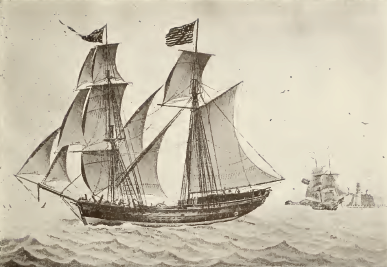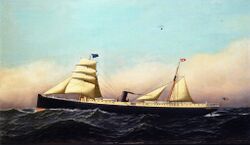Brigantine
Topic: Engineering
 From HandWiki - Reading time: 4 min
From HandWiki - Reading time: 4 min
| Brigantine | |
|---|---|
 Brigantine Experiment of Newburyport, 114 tons, built at Amesbury in 1803 | |
| Type | Sailing rig |
| Place of origin | Atlantic maritime nations |
A brigantine is a two-masted sailing vessel with a fully square-rigged foremast and at least two sails on the main mast: a square topsail and a gaff sail mainsail (behind the mast).[1] The main mast is the second and taller of the two masts.
Older usages are looser; in addition to the rigorous definition above (attested from 1695), the Oxford English Dictionary has about 1525 definitions of "a small vessel equipped both for sailing and rowing, swifter and more easily manœuvred than larger ships" and "(loosely) various kinds of foreign sailing and rowing vessels, as the galleon, galliot, etc."[2]
Modern American definitions include vessels without the square sails on the main mast.
Mediterranean brigantines
In the Mediterranean Basin during the 13th century, a brigantine referred to a sail- and oar-driven war vessel.[3] It was lateen rigged on two masts and had between eight and twelve oars on each side. Its speed, maneuverability, and ease of handling made it a favourite of Mediterranean pirates. Its name is derived from the Italian word brigantino, which in turn is derived from brigante[4] "brigand". Other than in names, this vessel has no relation to the later brigantines developed in Northern Europe.[citation needed]
17th century and onwards
By the 17th century, the term was adopted by Atlantic maritime nations. The vessel had no lateen sails, but was instead square-rigged on the foremast and had a gaff-rigged mainsail with square rig above it on the mainmast.[5] The mainmast of a brigantine is the aft one.
By the first half of the 18th century, the word had evolved to refer not to a kind of vessel, but rather to a particular type of rigging: two-masted, with her foremast fully square-rigged and her mainmast rigged with both a fore-and-aft mainsail (a gaff sail) and square topsails and possibly topgallant sails.[1]
The brigantine was the second-most popular rig for ships built in the British colonies in North America before 1775[6] The most popular type of vessel was the sloop. The brigantine was swifter and more easily maneuvered than a sloop or schooner, hence was employed for piracy, espionage, and reconnoitering, and as an outlying attendant upon large ships for protecting a ship, or for supply or landing purposes in a fleet.
The brigantine could be of various sizes, ranging from 30 to 150 tons burden.[6] The brigantine was generally larger than a sloop or schooner, but smaller than a brig.[3]
Modern terminology

The definition given above describes the international usage of the term brigantine. In modern American terminology, the term brigantine now usually means a vessel with the foremast square rigged and the mainmast fore-and-aft rigged, without any square sails. Historically, this rig used was called a schooner brig' or hermaphrodite brig.[7] In Europe, the distinction is typically still made. The training ship Zebu, which circumnavigated the Earth as part of Operation Raleigh, is an example of a schooner brig.
Differences from brig
The word brig is an 18th-century shortening of the word brigantine, but to mean a different type of rigging.[citation needed] The gaff-rigged mainsail on a brigantine distinguishes it from the brig, which is principally square-rigged on both masts.[citation needed] In addition to the different sail configuration, the brigantine's mainmast is made from two parts and equal to that of a schooner, a quite long mast and a top mast.[citation needed] The mainmast of a brig is made from three parts and equal to that of a fully rigged ship - a mast, topmast, and topgallant mast. With the advent of modern (metal) pole masts, this last difference typically no longer exists.[citation needed]
See also
- Snow (ship)
- Brig (ship)
References
- ↑ 1.0 1.1 Sandström, Fredrik (2000). "Brigantine (Archived copy)". http://sailing-ships.oktett.net/brigantine.html#.
- ↑ brigantine (3rd ed.), Oxford University Press, September 2005, http://www.oed.com/view/Entry/23300 (Subscription or UK public library membership required.)
- ↑ 3.0 3.1 Haalmeijer, Hans (2006) (in nl). Aken, tjalken en kraken: zeilschepen van de Lage Landen : de binnenvaart.. De Alk. ISBN 978-90-6013-274-6. https://books.google.com/books?id=szDVygAACAAJ.
- ↑ "'Brigantino'" (in it). Dizionario Etimologico Online. http://www.etimo.it/?term=brigantino.
- ↑ Kemp, Peter, ed (1994). The Oxford Companion to Ships and the Sea. Oxford: Oxford University Press. ISBN 9780192115539. https://archive.org/details/oxfordcompaniont00kemp.
- ↑ 6.0 6.1 "Brigentines Described". http://www.gaspee.info/history/shipsdescribed/brigentineDescribed.htm.
- ↑ "brigantine". http://universalium.academic.ru/85396/brigantine.
External links
- El bergantín goleta "Jaime Soberano segundo" (in Spanish)
 |
 KSF
KSF

